
Pasta is so popular it has it’s own day. Some might say everyday, right? Well yes, as much as the world loves pasta World Pasta Day was only established as recently as 1998.
Alongside pizza, pasta is easily one of the most iconic Italian exports, coming in all manner of shapes, sizes, flavours and combinations.
We can’t think of a better day to share our favourite pasta recipes than World Pasta Day 2016 – which falls every single year on the 25th October.
Cooking pasta properly can be and often is a nightmare for many, there are quite a few nuances to be mastered before you can create the perfect pasta.
Every type of pasta needs a slightly different cooking time, or preparation method before even cooking.
The problem with our pasta is often that we don’t use enough water or salt when we cook our pasta.
Our resident Italian (yes we are both blessed and cursed to have an Italian working within our ranks) has confided that we don’t use the correct amount of salt when cooking pasta.
The rule of thumb is that we should use 1 litre of water for every 100g of pasta. So 400g of pasta will require 4 litres of water.
This is way more than most will be used to using!
Now the salt.
Yet another rule of thumb, 10g of salt for every 100g of pasta. So 400g of pasta and 4 litres of water will require 40g of coarse salt.
Almost all pasta you use will contain no salt whatsoever, this is why we need to add so much salt to the water.
Not only does adding salt add flavour to your pasta, it actually decreases the amount of time it takes to bring your water to the boil.
As for the amount of water, pasta needs room to move whilst cooking, too little water and it can become sticky, overly starchy and won’t cook properly.
Quality al dente pasta is something we all dream of, but now with this simple advice it can be a reality.
Fettuccine al ragù
Ingredients
- 1 white onion
- 1 carrot
- 1 celery stalk
- 50g pancetta or unsmoked bacon
- 50g butter
- 3 tablespoons extra-virgin olive oil
- 1 bay leaf
- 400g minced beef
- 300g minced pork
- 200ml red or white wine
- 1 tablespoon tomato concentrate dissolved in 100ml warm water
- 150ml whole milk
- 450g egg fettuccine, tagliatelle or farfalle, ideally fresh, but best-quality dried if not
- 5 tablespoons grated Parmesan
- salt and freshly ground black pepper
Method
- Finely chop the onion and carrot along with the celery and pancetta. Some people like to do this in a food processor.
- In a large, heavy-based saucepan or deep frying pan with a lid, heat the olive oil and butter, add the vegetables and pancetta with the bay leaf and cook over a low heat until they are soft and fragrant, and the pancetta has rendered much of its fat and is starting to colour. This will take about 8 minutes. Increase the heat slightly, then crumble the minced meat into the pan and cook, stirring pretty continuously, until the meat has lost all its pink colour and has browned evenly.
- Add the wine, turn up the heat and let it evaporate for a couple of minutes before adding the tomato. Simmer, covered, over a low heat for 30 minutes, by which time the sauce should have deepened in colour and have very little liquid. Add a teaspoon of salt, lots of black pepper and a little of the milk.
- Cook slowly, covered, for another hour over a low heat, every so often lifting the lid and adding a little of the milk until it is used up. The sauce should be rich and thick with no liquid, but not dry either, so keep a careful eye on it. When you’re ready to eat, bring a large pan of water to a fast boil and, if it isn’t already hot, gently reheat the ragù.
- Warm a serving bowl.
- Once the water has come to a fast boil, add salt, stir, gently drop in the pasta and cook, stirring every now and then, until it is al dente. For fresh fettuccine or tagliatelle this will only take a few minutes, but farfalle will take slightly longer. For dried pasta, check the timing on the packet and start tasting 2 minutes earlier.
- Drain the pasta and turn it into the serving bowl (reserving a little pasta-cooking water), sprinkle over the cheese, then add the sauce.
- Stir carefully, lifting the pasta from below with two wooden spoons, so it is well coated with sauce. If it seems a bit dry, cautiously add a little of the reserved pasta-cooking water and toss again. Serve.
Or for perfect pasta without any fuss or hassle you could always get yourself a dedicated pasta boiler…designed by pasta experts to produce large quantities of quality pasta products just at the touch of a button.
And there you have one of the most simple yet tasty Italian dishes you’re ever likely to prepare.
Just FYI Spagehtti bolognese is not a thing in Italy. Bolognese is served traditionally with tagliatelle, serving with spaghetti is a no-no.
If you want to learn more about World Pasta Day then visit www.pasta-unafpa.org for more information.
